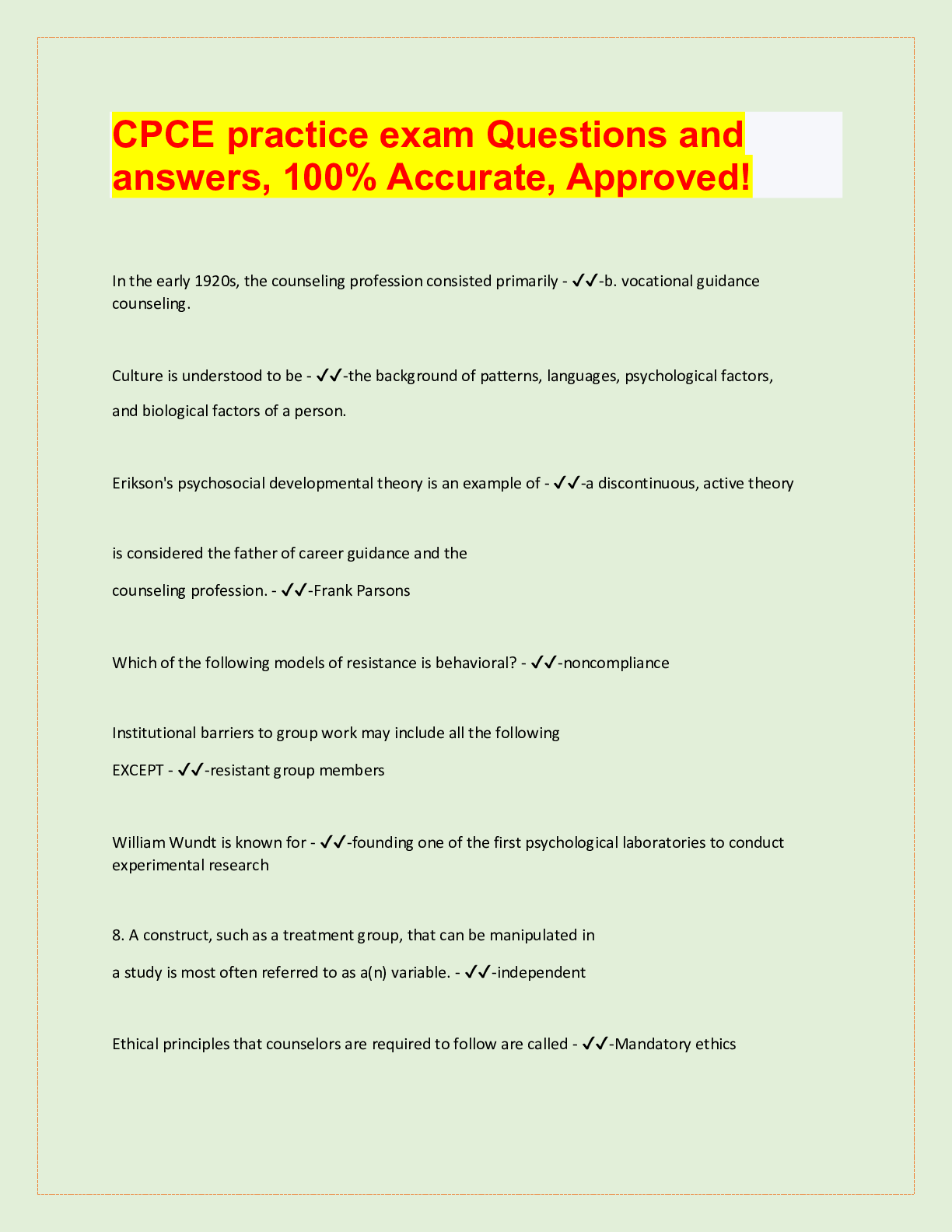Marketing > QUESTIONS & ANSWERS > Chapter 10—Effective and Creative Ad Messages. All Answers Correct (All)
Chapter 10—Effective and Creative Ad Messages. All Answers Correct
Document Content and Description Below
TRUE/FALSE 1. Effective advertising takes the consumer’s view. T PTS: 1 2. Effective advertising should promise more than it can deliver. F PTS: 1 3. Creative ads share two featu... res: originality and appropriateness. T PTS: 1 4. A value proposition is the essence of a message and the reward to the consumer for investing his or her time attending an advertisement. T PTS: 1 5. “Agency mistakes” result from the agency’s failure to identify a meaningful value proposition that distinguishes the brand from competitive offerings. F PTS: 1 6. Account managers are the voice of the customer. F PTS: 1 7. A creative brief is a document designed to channel copywriters’ and other creatives’ efforts toward a solution that will serve the interests of the client. T PTS: 1 8. It is solely the advertiser’s job to identify what medium is best for reaching the target audience. F PTS: 1 9. Functionally-oriented advertising appeals to consumers’ needs for tangible, physical, concrete benefits. T PTS: 1 10. The generic creative style consists of an advertiser making a superiority claim based on a unique product attribute that represents a meaningful, distinctive consumer benefit. F PTS: 1 11. The brand-image creative style attempts to develop an image or identity for a brand by associating the product with symbols. T PTS: 1 12. The resonance creative style structures an advertising campaign to pattern the prevailing lifestyle orientation of the intended market segment. T PTS: 1 13. The emotional style can be used when advertising virtually any brand, but it is best not to appeal to negative emotions. F PTS: 1 14. An advertiser employs a generic creative style when making a claim that could be made by any company that markets a brand in that product category. T PTS: 1 15. The generic creative style is most appropriate for a company that dominates a product category. T PTS: 1 16. A preemptive creative style is employed when an advertiser makes a generic-type claim but does so with an assertion of superiority. T PTS: 1 17. The preemptive creative style is a clever strategy when a meaningful superiority claim is made because it effectively precludes competitors from saying the same thing. T PTS: 1 18. Advertisements containing functional-only appeals are more effective than advertisements containing both functional and psychosocial appeals. F PTS: 1 19. Attributes are what consumers hope to receive or avoid when consuming products. F PTS: 1 20. An attribute for a brand of automobiles might be engine performance. T PTS: 1 21. Consequences are what consumers hope to receive (benefits) or avoid (detriments) when consuming brands. T PTS: 1 22. Values represent those short-term beliefs people hold regarding what is important in life. F PTS: 1 23. The self-direction value includes the desire for freedom, independence, choosing one's goals, and creativity. T PTS: 1 24. The value of universalism is derived from the need for variety and achieving an exciting life. F PTS: 1 25. MECCAS is an acronym for Means-End Conceptualization of Components for Advertising Strategy. T PTS: 1 26. The MECCAS model provides a procedure for applying the concept of means-end chains to the creation of advertising messages. T PTS: 1 27. According to the MECCAS model, the value orientation represents the product value level on which the advertising style focuses and can be thought of as the driving force behind the advertising execution. F PTS: 1 28. Laddering is a marketing research technique that has been developed to identify links between attributes, consequences, and values. T PTS: 1 29. Laddering involves short, one-on-one interviews that typically last between 5 to 10 minutes. F PTS: 1 30. Two distinct forms of corporate advertising are image and issue advertising. T PTS: 1 31. Corporate image advertising involves a company taking a position on a controversial social issue of public importance with the intention of swaying public opinion. F PTS: 1 MULTIPLE CHOICE 1. Which of the following is FALSE regarding effective advertising? a. It must extend from sound marketing strategy. b. Effective advertising must take the advertiser’s view. c. Advertising must find a unique way to break through the clutter. d. Good advertising should never promise more than it can deliver. e. Good advertising prevents the creative idea from overwhelming the strategy. B PTS: 1 2. Which of the following is a feature of creative ads? a. novelty b. appropriateness c. intensity d. a and b only e. a, b, and c D PTS: 1 3. _____ addresses the matter of whether an advertisement reflects empathy with the target audience’s basic needs and wants as they relate to making a brand-choice decision in a particular product category. a. Appropriateness b. Novelty c. Stickiness d. Concreteness e. Connectedness E PTS: 1 4. One facet of ad creativity, appropriateness, means that _____. a. an advertisement does not offend the target audience b. an advertisement wins creativity awards from advertising trade associations c. an advertisement offers a useful solution to a marketing problem d. the methods, techniques, and copy are novel for the product category e. it is typical of advertisements for that product category A PTS: 1 5. _____ is a necessary but insufficient condition for advertising creativity. a. Humor b. Imagery c. Synergy d. Novelty e. Symbolism D PTS: 1 6. Advertising messages a target audience comprehends as is intended by the advertiser that are remembered, and that change the audience’s brand-related opinions or behavior are referred to as _____ ads. a. slice-of-life b. generic c. sticky d. novel e. advocacy C PTS: 1 7. Advertisements that violate the _____ feature fail to capture the brand’s critical essence— its positioning strategy—or present excessive information that dilutes the message of the brand’s essence. a. unexpectedness b. simplicity c. novelty d. concreteness e. credibility B PTS: 1 8. _____ is based on the idea that it is easier for people to remember and retrieve tangible rather than abstract information. a. Concretizing b. Novelty c. Effectiveness d. Simplicity e. Appropriateness A PTS: 1 9. Advertisers can get people to care about their brands by appealing to _____ that are relevant to the product category in which the advertised brand competes. a. benefits b. emotions c. motivations d. rational thoughts e. behaviors B PTS: 1 10. The essence of a message and the reward to the consumer for investing his or her time attending an advertisement is known as a(n) _____. a. value proposition b. creative brief c. appropriateness summary d. uniqueness proposition e. message summary A PTS: 1 11. _____ occur when the advertising agency comes up with a good, creative execution, but this cannot make up for the absence of a convincing value proposition. a. Successful campaigns b. Marketing mistakes c. Agency mistakes d. Complete disasters e. Successful executions B PTS: 1 12. A document designed to channel copywriters’ and other creatives’ efforts toward a solution that will serve the interests of the client is known as a(n) _____. a. advertising platform b. creative platform c. creative copy d. advertising copy e. creative brief E PTS: 1 13. Which of the following would NOT be included in a creative brief? a. background b. target audience c. creative style d. positioning e. objectives and measures C PTS: 1 14. Those performing the “creative” function in the advertising-development process must know the audience for the advertisements they are to create. This “audience” is also referred to as the _____. a. client b. focus group c. target market d. trade e. prospects C PTS: 1 15. Although not a typical practice in the ad industry when constructing creative briefs, it is desirable to indicate not only what objectives are to be accomplished but also _____. a. how analyses will be conducted b. who will be responsible for various tasks c. why these objectives are appropriate d. how achievement of the objectives will be measured e. what is expected of the client D PTS: 1 16. Beyond thoughts and feelings, the creative brief focuses on the specific _____ the advertising campaign is designed to motivate in the target audience. a. memories b. cognitive connections c. schemata d. attitudes e. action E PTS: 1 17. In the creative brief, the brand management team must clearly articulate the brand’s _____. a. price b. benefits c. features d. meaning e. distribution D PTS: 1 18. _____ advertising appeals to consumers’ needs for tangible, physical, concrete benefits. a. Symbolically-oriented b. Experientially-oriented c. Functionally-oriented d. Transformational e. Factually-oriented C PTS: 1 19. The unique selling proposition style is a _____ advertising strategy. a. functionally-oriented b. symbolically-oriented c. experientially-oriented d. category-dominance e. category-oriented A PTS: 1 20. _____ strategies do not necessarily use any particular type of appeal to consumers but are designed to achieve an advantage over competitors in the same product category. a. Symbolically-oriented b. Functionally-oriented c. Experientially-oriented d. Category-dominance e. Functionally-dominant D PTS: 1 21. The generic and preemptive creative strategies are _____ strategies. a. functionally-oriented b. symbolically-oriented c. experientially-oriented d. category-dominance e. category-oriented D PTS: 1 22. The brand image, resonance, and emotional creative strategies are _____ strategies. a. functionally-oriented b. symbolically/experientially-oriented c. category-dominance d. category-oriented e. consumer-oriented B PTS: 1 23. Which of the following is an advertising creative style? a. unique selling proposition b. brand image c. resonance d. generic e. All of these are correct. E PTS: 1 24. In which creative style does an advertiser make a superiority claim based on a unique product attribute that represents a meaningful, distinctive consumer benefit? a. unique selling proposition b. brand image c. resonance d. emotional e. generic A PTS: 1 25. Advertisements for athletic shoes often focus on technological features such as special shock-absorbing sole construction. What creative advertising style is being used when the advertising for a brand of athletic shoes focuses on a particular technological feature? a. resonance b. preemptive c. unique selling proposition d. positioning e. brand image C PTS: 1 26. A manufacturer of automobiles that advertises as the only automobile where you can unlock the door with your thumb print, is using the _____ creative style. a. preemptive b. unique selling proposition c. positioning d. resonance e. emotional B PTS: 1 27. The _____ creative style involves psychological, rather than physical, differentiation. a. preemptive b. generic c. positioning d. unique-selling proposition e. brand image E PTS: 1 28. Jif Peanut Butter has long used the slogan “Choosy mothers choose Jif.” This campaign does not directly challenge competitors but instead relies upon an understanding of the consumer’s desire to be perceived as a good parent. Hence, in the sense that Jif is being advertised as the “good-parent peanut butter,” what advertising style is being used? a. resonance b. brand image c. unique selling proposition d. positioning e. emotional B PTS: 1 29. Levi’s 501 and 502 jeans are advertised as casual clothes for fashion-conscious young people. In comparison, J.C. Penney advertises their Plain Pockets as no-nonsense and more economical than the name brands. J.C. Penney is practicing what type of advertising style? a. resonance b. unique selling proposition c. brand image d. emotional e. generic C PTS: 1 30. _____ advertising associates the experience of using an advertised brand with a unique set of psychological characteristics that typically would not be associated with the brand experience to the same degree without exposure to the advertisement. a. Informational b. Resonance c. Preemptive d. Suggestive e. Transformational E PTS: 1 31. The _____ creative style extends from psychographic research and structures an advertising campaign to pattern the prevailing lifestyle orientation of the intended market segment. a. generic b. preemptive c. positioning d. resonance e. brand-image D PTS: 1 32. Which creative style does not focus on product claims or brand images but rather seeks to present circumstances or situations that find counterparts in the real or imagine experiences of the target audience, attempting to match “patterns” in an advertisement with the target audience’s stored experiences? a. unique selling proposition b. resonance c. generic d. emotional e. preemptive B PTS: 1 33. Your company markets a molded-plastic product that is shaped like a baseball and is used as an inventorying device for storing baseball cards. You will advertise this product as a gift item to be purchased by parents of young children. Your advertising will feature the nostalgia of collecting baseball cards. What creative style are you using? a. preemptive b. unique selling proposition c. resonance d. generic e. brand image C PTS: 1 34. The emotional creative style would work especially well for _____. a. food b. jewelry c. cosmetics d. soft drinks e. All of these are correct. E PTS: 1 35. The _____ creative style is employed when an advertiser makes no attempt to differentiate its brand from competitive offerings nor to claim superiority. a. preemptive b. positioning c. resonance d. emotional e. generic E PTS: 1 36. The generic creative style is most appropriate for a company that _____. a. has a lower price than their major competitor b. has a higher price than their major competitor c. dominates a product category d. has a major competitive advantage over their major competitors e. sells a high percentage of their products to foreign markets C PTS: 1 37. The _____ creative style is employed when an advertiser makes a generic-type claim but does so with an assertion of superiority. a. preemptive b. unique selling proposition c. positioning d. resonance e. emotional A PTS: 1 38. Sunshield is a new line of sunglasses that boasts lenses that grow progressively darker with increasing sunlight. Other brands have this same type of lens, but Sunshield is the first to make the claim that its product helps prevent sun lines and aging of skin. What type of creative advertising style is described here? a. resonance b. preemptive c. unique selling proposition d. brand image e. positioning B PTS: 1 39. Most personal computers purchased by households are acquired primarily to assist children in their school work. In referring to its brand of PC, one computer company came up with the clever advertising line “The teacher’s aid.” This line is the only notable aspect of the company’s advertising. What creative style is the company employing? a. preemptive b. unique selling proposition c. resonance d. brand image e. emotional A PTS: 1 40. A(n) _____ represents the linkages among brand attributes, the consequences obtained from using the brand, and the personal values that the consequences reinforce. a. means-end chain b. ladder c. mecca d. interconnect e. value connect A PTS: 1 41. Features or aspects of advertised brands are known as _____. a. consequences b. values c. specifics d. perspectives e. attributes E PTS: 1 42. The _____ are what consumers hope to receive or avoid when consuming products. a. consequences b. values c. specifics d. attributes e. sections A PTS: 1 43. Harriett purchased a very expensive watch. The _____ of wearing the watch is the status that Harriett is seeking. a. attributes b. power c. specifics d. values e. consequences E PTS: 1 44. Enduring beliefs people hold regarding what is important in life are known as _____. a. attributes b. values c. norms d. roles e. consequences B PTS: 1 45. Which of the following is a universal value? a. self-direction b. hedonism c. achievement d. benevolence e. All of these are correct. E PTS: 1 46. Which of the following is NOT a universal value? a. stimulation b. security c. feminism d. conformity e. benevolence C PTS: 1 47. Which value is derived from the need for variety and achieving an exciting life? a. self-direction b. hedonism c. achievement d. stimulation e. tradition D PTS: 1 48. Enjoying life and receiving pleasure are fundamental to which universal value? a. self-direction b. stimulation c. hedonism d. achievement e. benevolence C PTS: 1 49. Marian is concerned with the preservation and enhancement of her family and friends. She is honest, loyal, and helpful. She possesses the _____ value. a. benevolence b. universalism c. conformity d. self-direction e. security A PTS: 1 50. According to the MECCAS model, the value orientation of an advertising style, or the end-level to be focused on in the advertising, is its _____. a. leverage point b. driving force c. message content d. media mix e. objectives B PTS: 1 51. In the terms of the MECCAS model, an advertisement that proclaims that pleasure and freedom will result from the purchase of a particular brand is using pleasure and freedom as _____. a. driving forces b. leverage points c. message elements d. consequences e. fulcrums A PTS: 1 52. A TV commercial for a sports car marketed to young people emphasizes pleasure and freedom as end levels. The advertised car is shown delivering these end levels when the car is transformed into a magic chariot and its young driver is carried away into a fantasyland. In terms of the MECCAS model, the magic chariot technique represents the commercial’s _____. a. driving force b. leverage point c. message elements d. consequences e. terminal values B PTS: 1 53. Laddering is a marketing research technique that has been developed to identify links between _____. a. attributes, consumers, and values b. attitudes, consumers, and values c. attributes, consequences, and variables d. attributes, consequences, and values e. attitudes, consequences, and values D PTS: 1 54. _____ involves in-depth, one-on-one interviews that typically last between 30 minutes to more than one hour and attempts to get at the root, or deep, reasons for why individual consumers buy certain products and brands. a. Chaining b. Laddering c. Dissecting d. Unraveling e. Peeling B PTS: 1 55. Which of the following is a criticism of the means-end approach and the method of laddering? a. The laddering method “forces” interviewees to identify hierarchies among attributes, consequences, and values that may actually not have existed before the interview and absent the interviewer’s directive probes. b. Consumers may possess clear-cut linkages between attributes and consequences but not necessarily between consequences and values. c. The ultimate hierarchy constructed through laddering is a crude aggregation of the ACV chains from multiple individuals into a single chain that represents the input into a MECCAS model. d. None of these are correct. e. All of these are correct. E PTS: 1 56. Which form of advertising focuses not on specific brands but on a corporation’s overall image or on economic or social issues relevant to the corporation’s interests? a. advocacy advertising b. corporate advertising c. non-profit advertising d. primary advertising e. secondary advertising B PTS: 1 57. Two distinct forms of corporate advertising are _____. a. image and issue b. primary and secondary c. product and service d. rational and emotional e. planned and unplanned A PTS: 1 58. _____ advertising attempts to increase a firm’s name recognition, establish goodwill for the company and its products, or identify itself with some meaningful and socially acceptable activity. a. Corporate image b. Corporate issue c. Advocacy d. Public service e. Institutional A PTS: 1 59. An insurance company's advertisements that mention how they contribute to cancer research would be using _____ advertising. a. corporate issue b. primary demand c. corporate image d. competitive e. reminder C PTS: 1 60. Corporate issue advertising is also known as _____ advertising. a. advocacy b. image c. goodwill d. selective demand e. pulsing A PTS: 1 61. An advertisement by Anheuser Busch, the manufacturer of Budweiser beer, stressing the importance of using a designated driver to curb drunken driving accidents is an example of _____ advertising. a. corporate image b. generic c. preemptive d. corporate issue e. preventive D PTS: 1 ESSAY 1. Assume that the advertising agency you work for is interested in writing a policy statement to describe the fundamental aspects of effective advertising. The statement will eventually appear in a promotional brochure for prospects and customers. Your assignment is to write the first draft of this statement. 2. Explain the six alternative creative strategies. For each style, provide an example of an actual advertisement that uses that style. 3. Explain the concepts of attributes, consequences, and values, and discuss the relationships among them. 4. Explain the MECCAS model, and discuss how it is used in advertising strategy formulation. 5. Compare and contrast corporate image advertising and corporate issue advertising, and provide an example of each. [Show More]
Last updated: 1 year ago
Preview 1 out of 16 pages
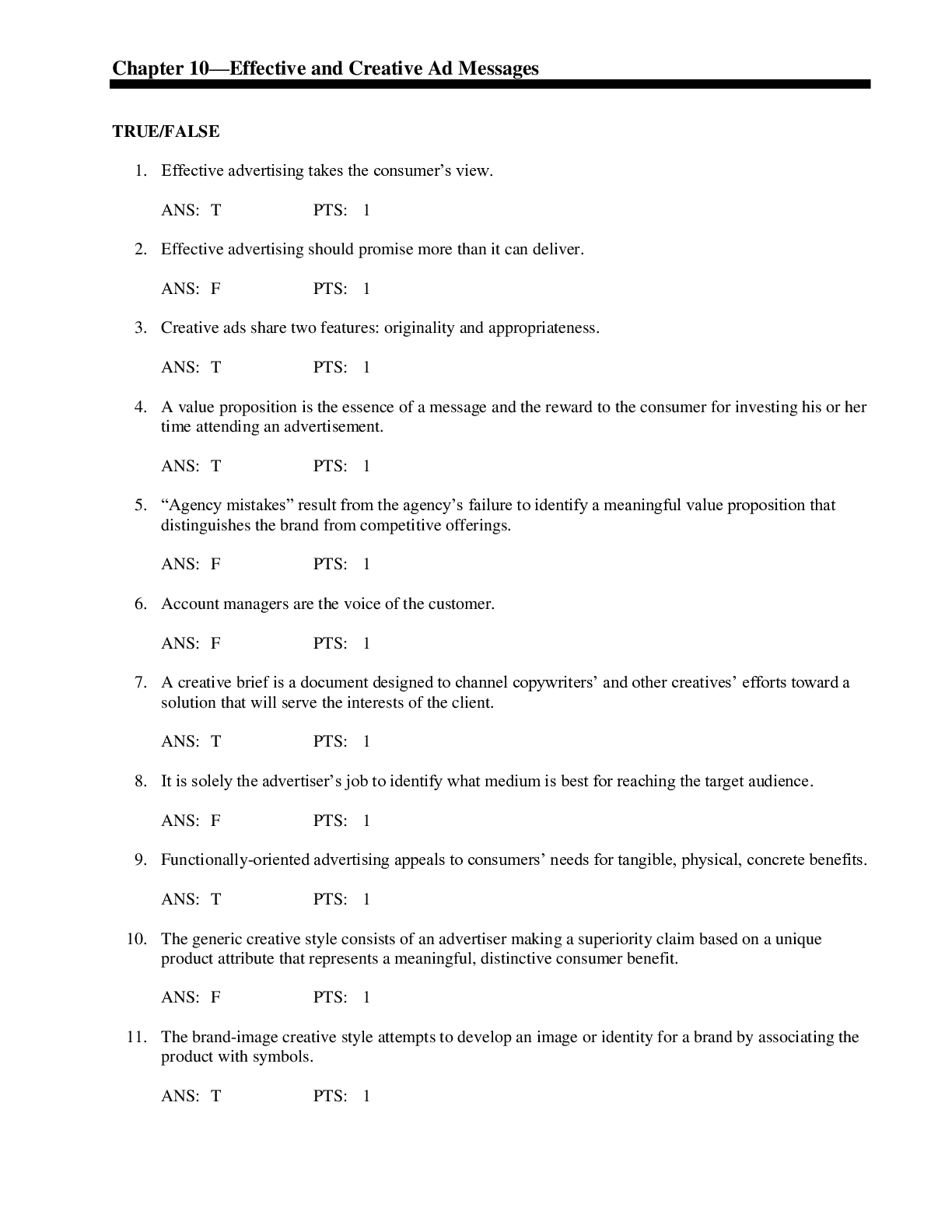
Reviews( 0 )
Document information
Connected school, study & course
About the document
Uploaded On
Nov 07, 2019
Number of pages
16
Written in
Additional information
This document has been written for:
Uploaded
Nov 07, 2019
Downloads
0
Views
158







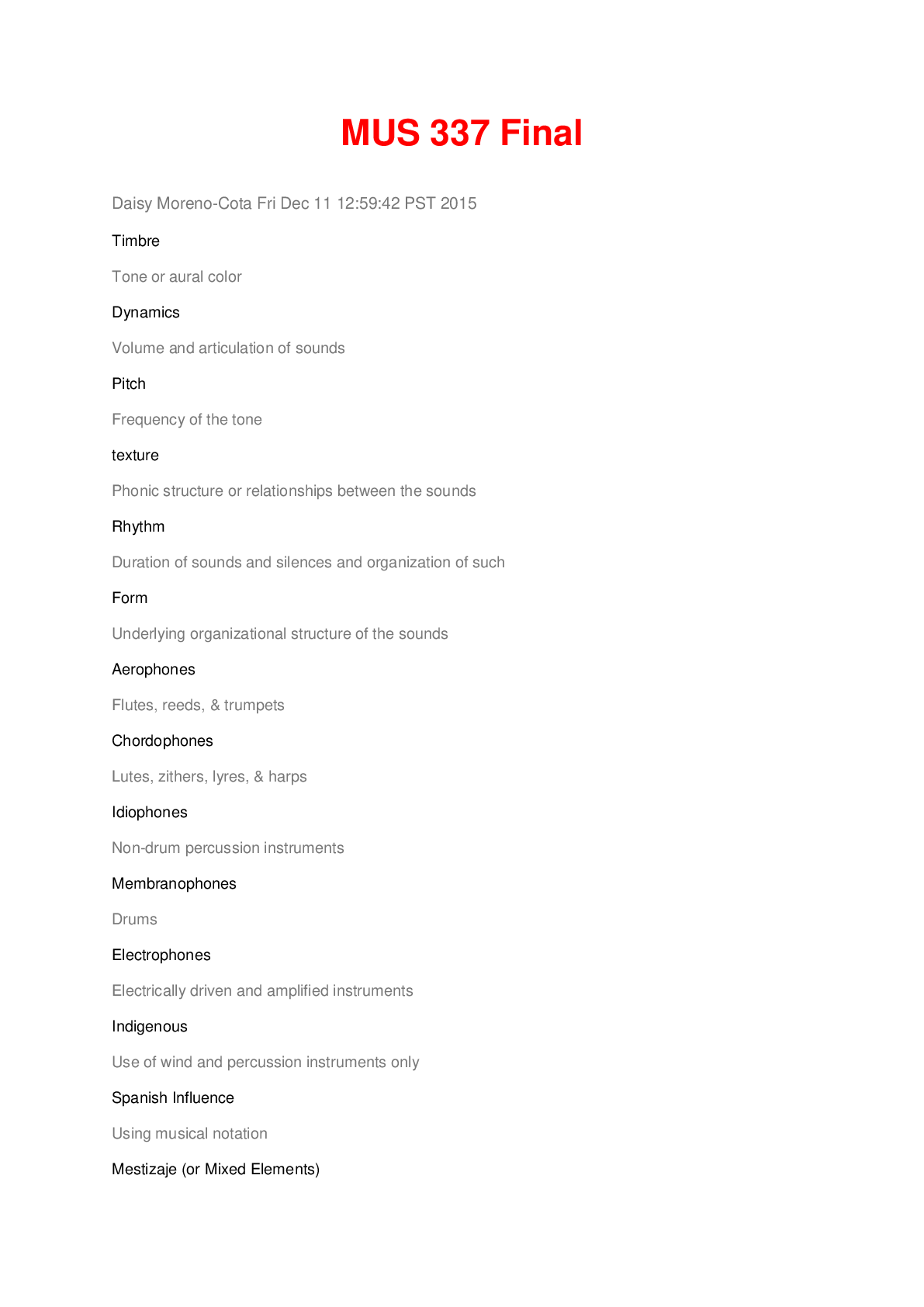




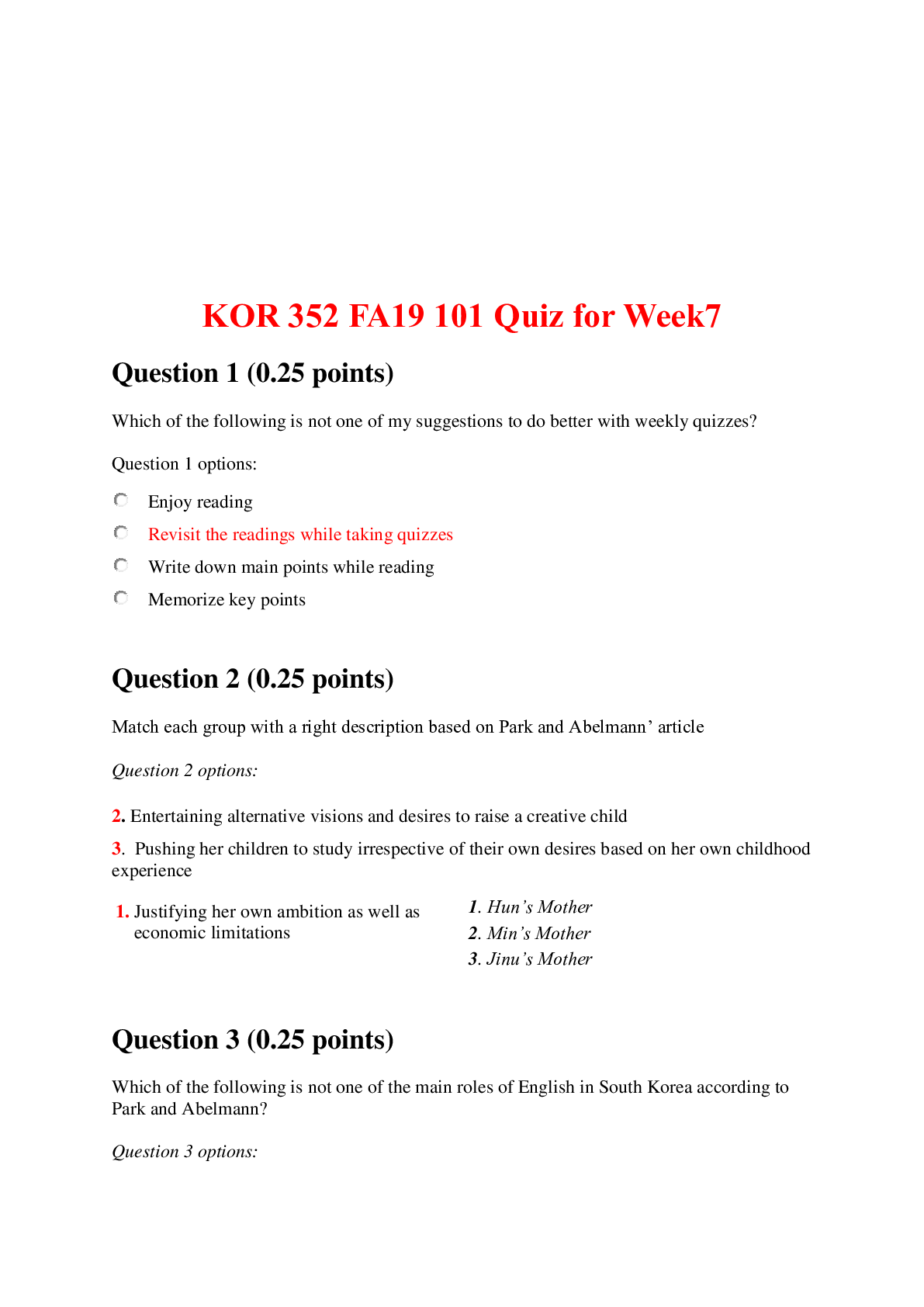


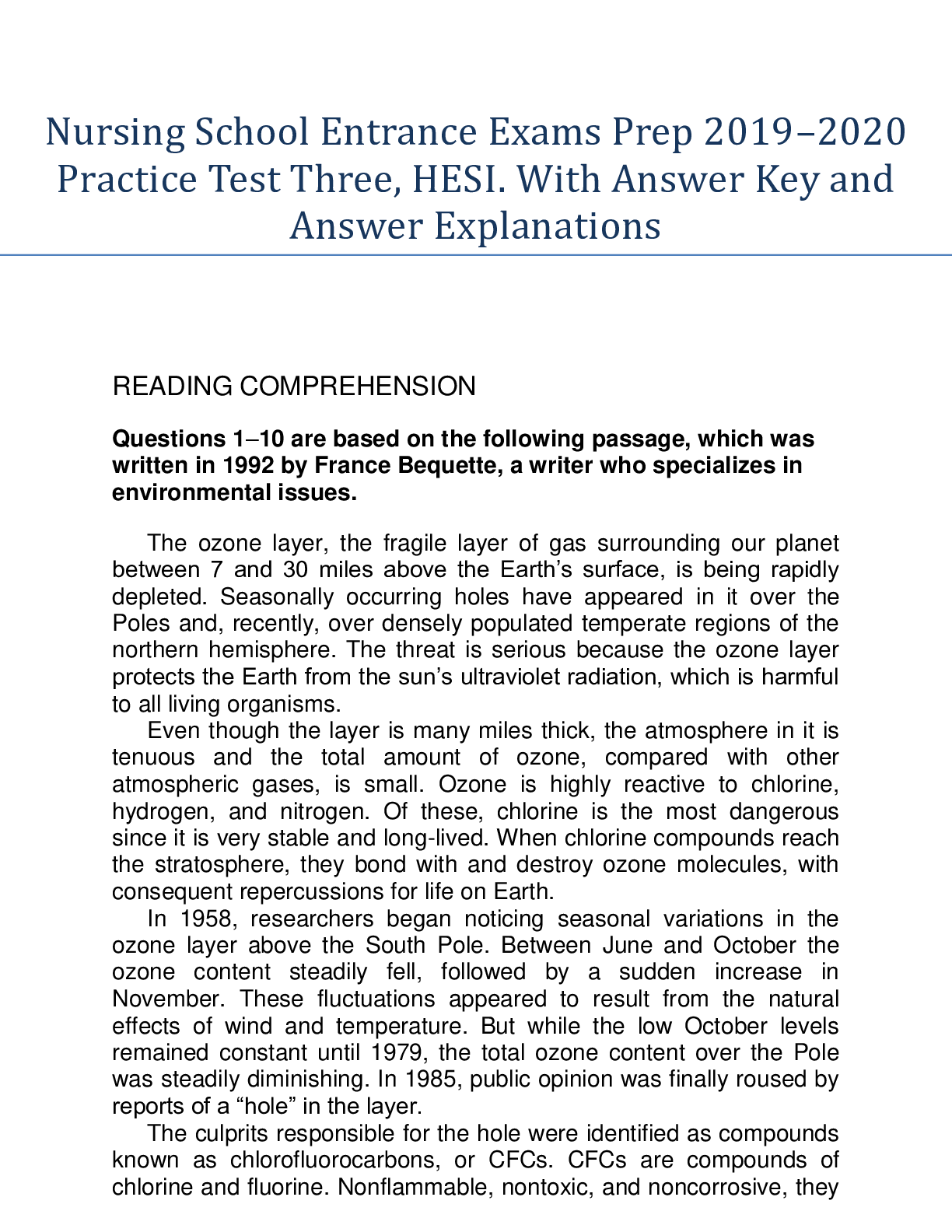
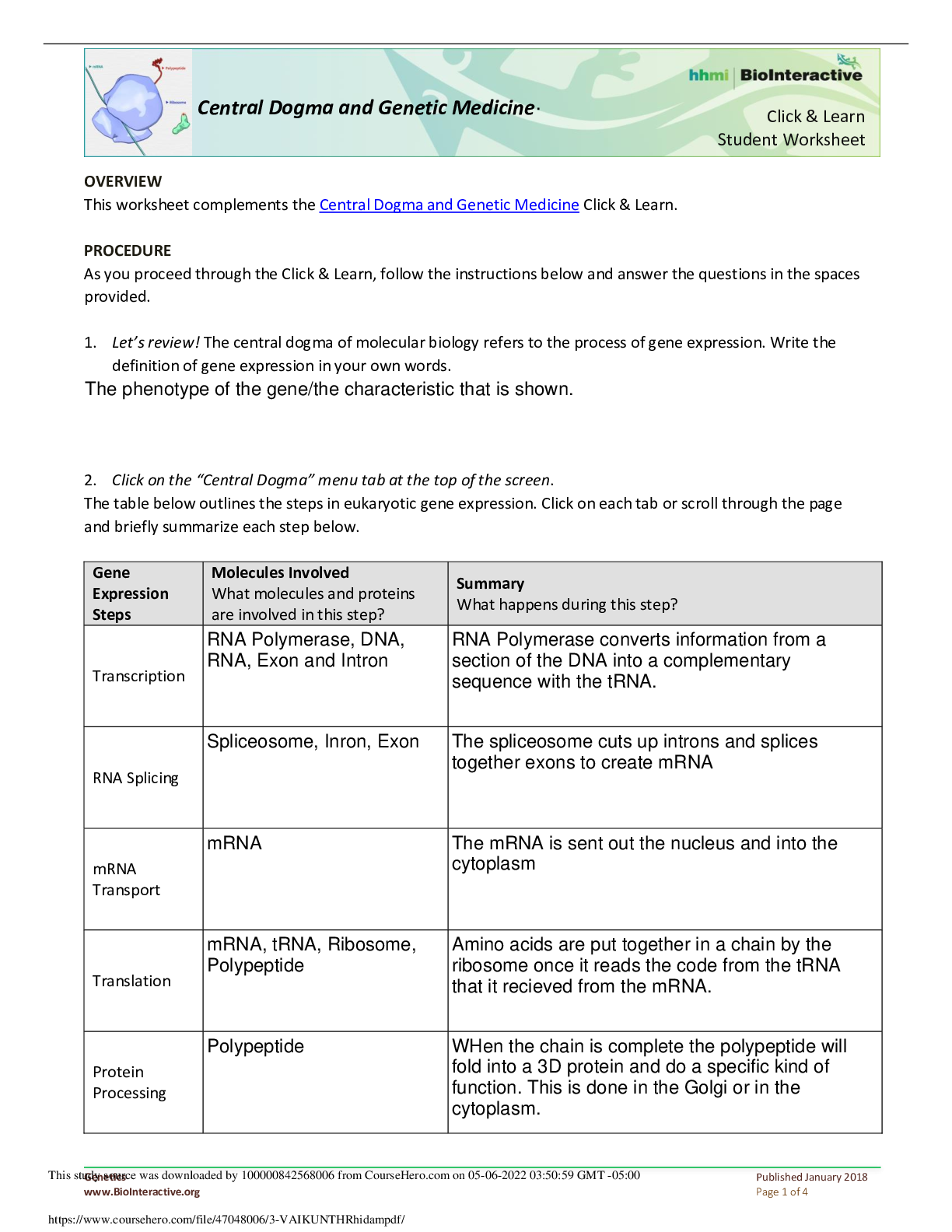


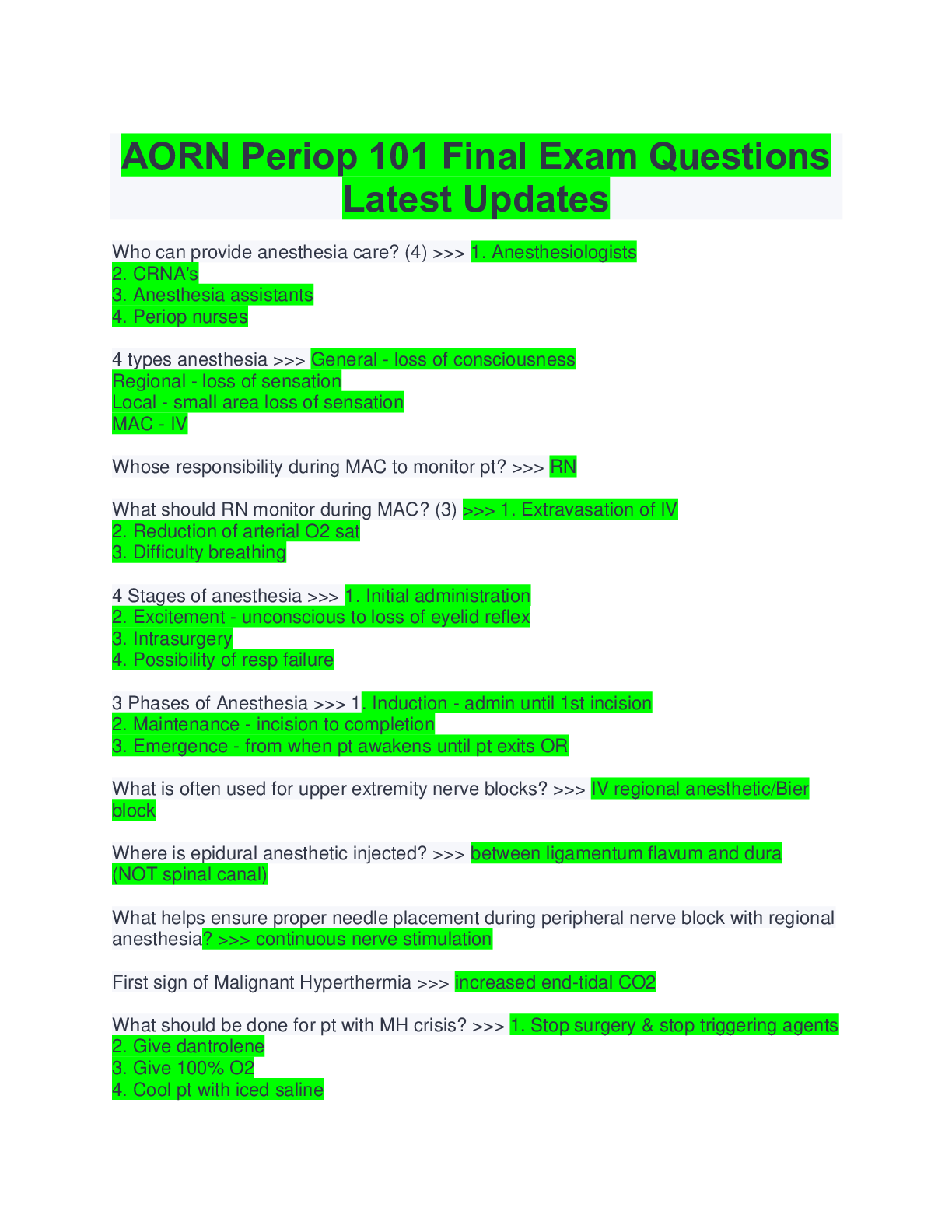










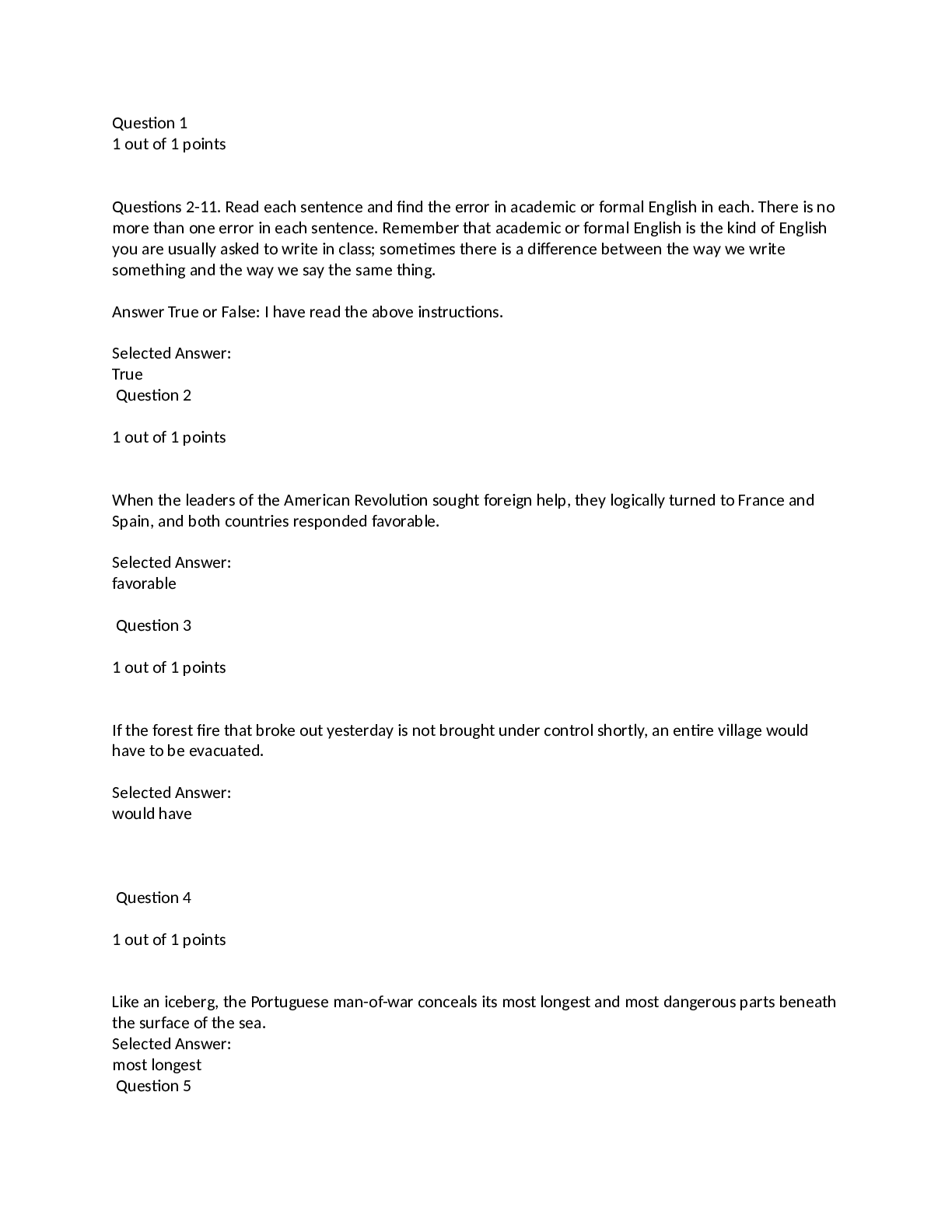
.png)
